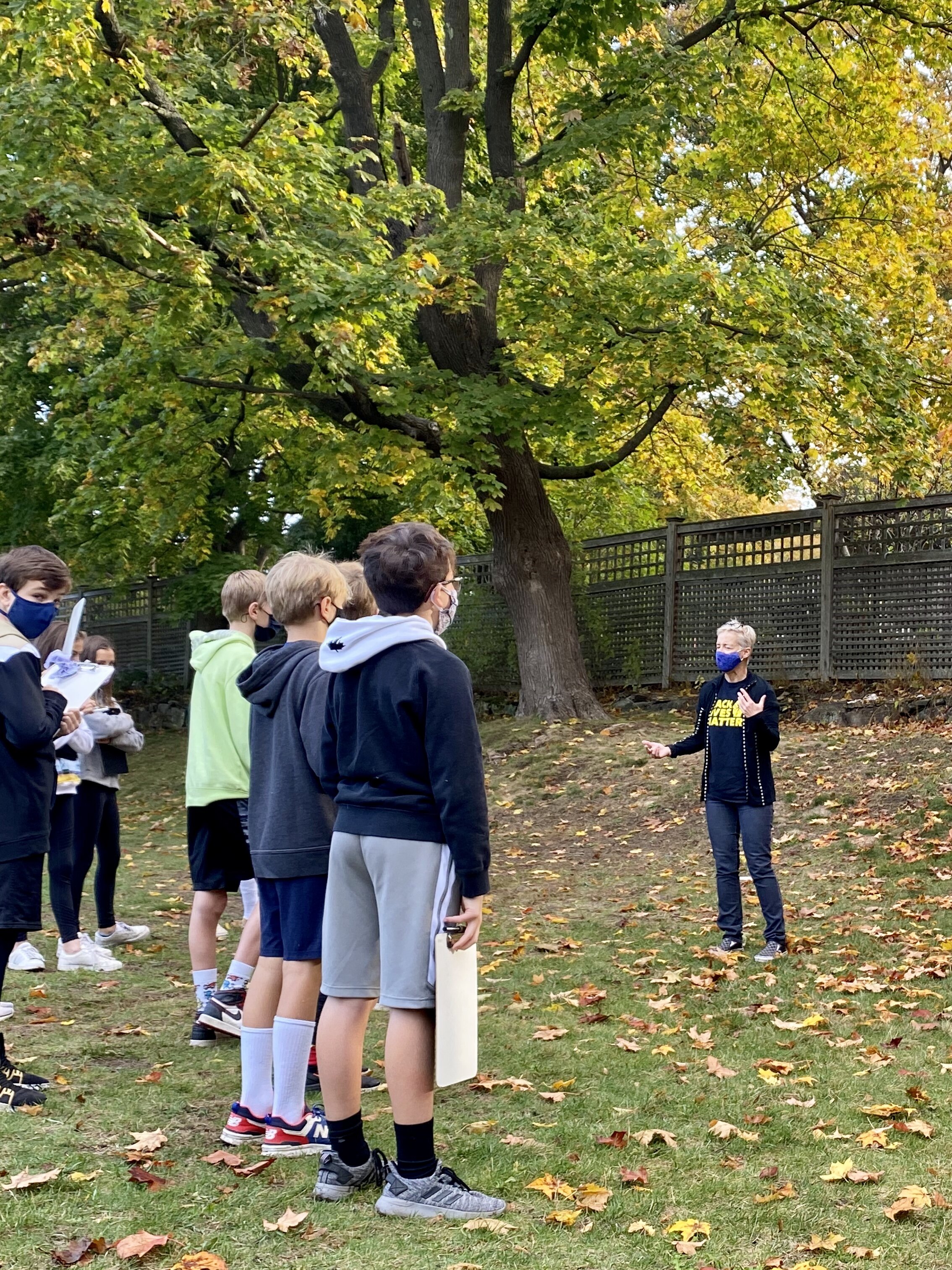How Do You Incorporate an Antiracist Curriculum into a Math Class? Step by Step.
Learning about privilege, race, and antiracism, in math class.
When I arrived at GUS, the school’s commitment to social justice was apparent in many ways. It was embedded in our mission and diversity statements, illustrated in Dr. Draper’s social studies curriculum, and evident in the school’s support of professional development on topics connected to diversity, equity, and inclusion. Prior to coming to GUS, I’d earned a degree in mathematics and computer sciences and worked as a software engineer for 16 years. When I moved to Gloucester, I returned to school to become a teacher. Fortuitously, my practicum was at the King Open School in Cambridge where Robert Moses founded The Algebra Project, a K-8 curriculum that treats access to Algebra as a civil right.
So how does one incorporate an antiracist curriculum into a math class? Step by step. I want students to be comfortable seeing race and talking about race. To be able to see how racism is rooted in slavery and continues today in the racist policies and practices that lead to inequity. In March 2020, after realizing I’d done nothing to recognize Black History Month, I developed and shared a four-day mini-introduction to Black history with 6th and 8th grade students, which I called “The Impact of Racism on Black History: Slavery, Jim Crow, The Great Migration, and Mass Incarceration. Black History is American History.” Students were engaged and outraged to learn how the racism of slavery is felt today in many U.S. policies and institutions. This fall, we have looked at CDC demographic data about the coronavirus and talked about how racism has led to the conditions where the Black community and people of color are disproportionately sickened and killed by the coronavirus. We have also learned how Black people and people of color are underrepresented in the fields of math and science. Students can tell you that from 1973 until 2012, 66 black American women earned physics doctorates while 22,172 white men earned their physics doctorates. During Hispanic Heritage Month (September 15 to October 15) we have used the Lathisms website for a daily introduction to a Latinx mathematician. On October 5th, the mathematician was a young man named Andrés R. Vindas Meléndez, the son of immigrants from Costa Rica. As he pursues his PhD, he is a math teacher who is focused on the questions: Whose voice is being heard? Who is present (or missing) in the classroom? How does privilege, race, class, language, gender, sexuality, etc. play a role in learning mathematics?
GUS students are learning about privilege and race, and I am so excited to be learning with them. Through GUS, I attended the People of Color Conference in the fall of 2018, traveled to Savannah, GA in the summer of 2019 to attend a five-day conference about Race, Power, and the Preservation of African-American History & Gullah-Geechee Culture in the Lowcountry, and attended the White Privilege Symposium in the Fall of 2019. Over Spring Break in March 2020, I set out on a trip to Alabama to visit Birmingham, Selma, Tuskegee, and Montgomery, and returned one day before everything shut down due to the coronavirus pandemic. In Montgomery, I’d visited two major institutions that make public and accessible the racist history and heritage of slavery. Established by Bryan Stevenson and the Equal Justice Initiative, I visited The National Memorial for Peace and Justice - a memorial to acknowledge the lynchings of over 4000 Black men and women - and The Legacy Museum: From Enslavement to Mass Incarceration.
Not too long into the pandemic, Ahmaud Arbery was murdered by racists in Georgia. I noticed he was from a town close to where I had visited in the summer of 2019, and then learned Ahmaud was a cousin of one of the men I had met that summer. I shared the news of his murder with my 8th graders. They were outraged and saddened. At the time, the video of his murder had not been made public. Then George Floyd was murdered. Then Breonna Taylor was killed, and the US erupted in protest of police brutality. Over the summer, the country engaged in a prolonged embrace of what to do. Dr. Ibram X. Kendi’s 2019 book “How to be an Antiracist” became a must-read. Another book I read early in the summer was “White Kids: Growing Up with Privilege in a Racially Divided America” by Margaret Hagerman. She sought the answer to this question “How do white kids learn about race when they grow up in families that do not talk openly about race or acknowledge its impact?”
After the events of the spring and summer, GUS was quick to make a statement acknowledging the need for a response to the racist attacks, and to declare that as a school we can “Do Better”. The Diversity Equity and Inclusion Task Force is now aimed in this direction, as GUS begins the work of becoming an antiracist organization. To support this work, GUS had six members of the DEI Task Force participate in a Harvard-based intensive equity improvement clinic in August, through the Harvard RIDES project. Fourth-grade teacher Laura Doyle and I also attended the annual National Antiracist Teach-in in mid-August, which was hosted by Boston College High School. The virtual conference had three days of speakers exploring issues of racism and white supremacy. The overarching theme was knowing history. We cannot protect our students from the brutal history of slavery that white privilege is founded on. Understanding history and white privilege will allow GUS students to develop a commitment to being an antiracist.
On the second day of school this year, I wore my Black Lives Matter T-shirt and brought in a lawn sign which states “We Believe Black Lives Matter; No Human Is Illegal; Love Is Love; Women’s Rights Are Human Rights; Science Is Real; Water Is Life; Injustice Anywhere Is A Threat To Justice Anywhere.” In Math class, we began our discussion focusing on the first statement on the sign. We talked about the founding of Black Lives Matter and the math needed to explain how Black Americans and people of color are more likely to be victims of police brutality. We then explored how each of the other statements can be tied to racism: immigration policies and calling immigrants “illegals”; the intersectionality of sexism, racism, and LGBTQIA; the disasters of climate change and the coronavirus, and the imbalanced impact of these forces on people of color; the Flint, MI water poisoning in a largely Black community. I read Ibram X Kendi’s children’s book Antiracist Baby to my classes and discussed the 9 steps towards becoming an antiracist.
I look forward to studying other issues of racism in math class with this fine group of scholars. We will look at reparations, redlining, mass incarceration, and other ways that the racism rooted in slavery continues to maintain vastly different standards of living for American citizens. Math is a powerful tool. Hopefully, these lessons will lead our students to speak up and act out when they see racism.
Meaning Well, Speaking Well, and Doing Better.
This year as part of our commitment to advancing diversity, equity, and inclusion work at GUS, our entire school community will be engaged in topics connected to white privilege and antiracism. We’re excited to share how we have begun to bring this work into the classroom, and look forward to sharing more.


